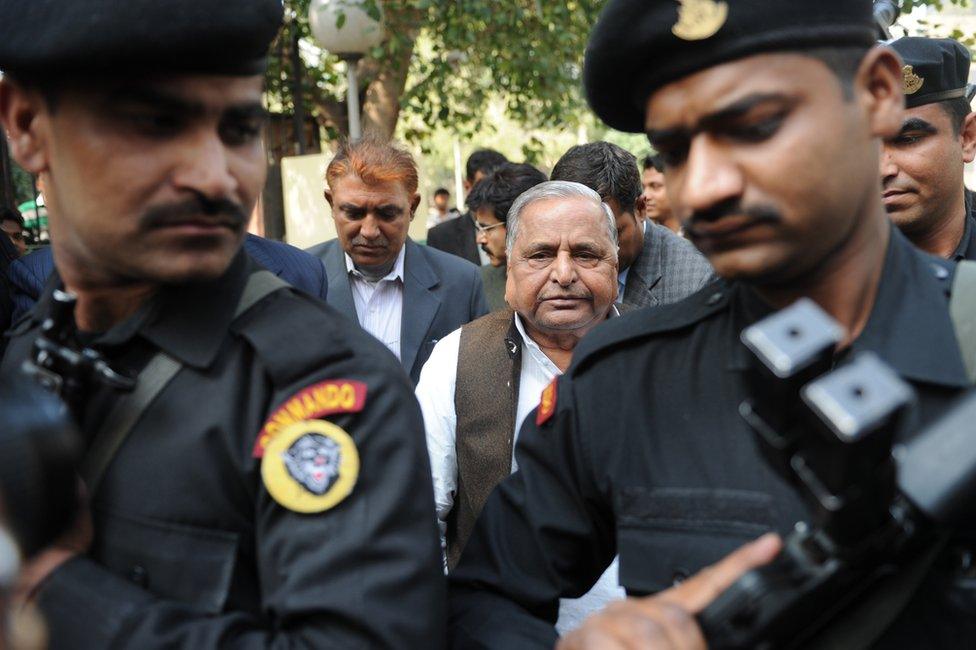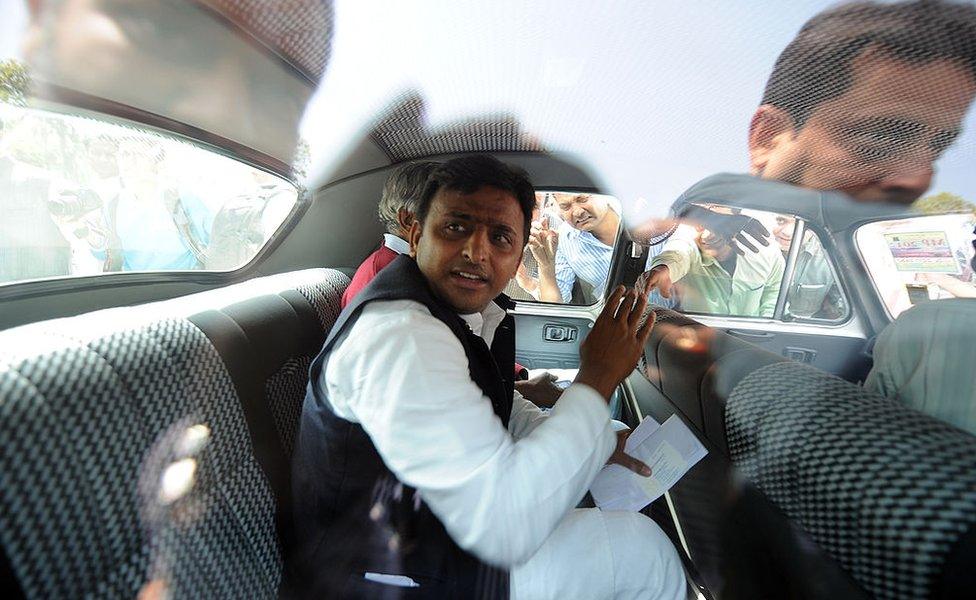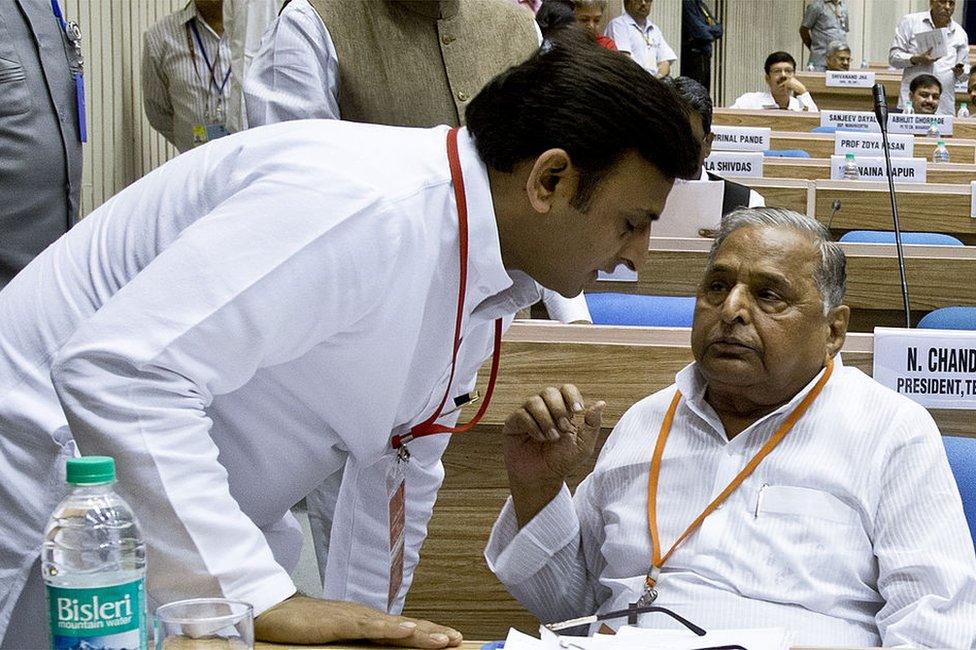The family feud rocking Indian politics
- Published

Mulayam Singh Yadav is the founder of the prominent Samajwadi Party...
As India's largest state - Uttar Pradesh - prepares to go to the polls early next year, its largest political dynasty - the Yadavs, whose Samajwadi Party heads the state government - is in disarray.
The Yadav family, reported to have 20 members and counting in politics, dominates the Samajwadi Party (SP) at all levels.
Its founder and patriarch, Mulayam Singh Yadav, is the national president of the party. His elder son Akhilesh Yadav is the chief minister of Uttar Pradesh.
Mulayam Singh Yadav's brother Shivpal Yadav is a minister in the state government. All SP members of the lower house of the Indian parliament are from the Yadav family. Other members occupy local and regional offices.
Old tensions
Even though political families now dominate, or are found burrowed within most major political parties in India, no other political family has the sheer numbers and sprawl across political offices at all levels of Indian politics that the Yadav family does.
Is India's politics becoming less dynastic?
But last month, old tensions among the Yadavs broke out into open conflict.
Akhilesh Yadav moved against his uncle Shivpal by sacking ministers and bureaucrats believed to be loyal to him.
Mulayam Singh Yadav backed his brother, removing his son from the position of state president of the Samajwadi Party and appointing Shivpal Yadav to the position instead.
For the past month, son and uncle and their respective factions have been fighting it out, with the patriarch playing mediator.

...and his elder son Akhilesh Yadav is the sitting chief minister of Uttar Pradesh
The drama is still unfolding. As of today, several of Akhilesh Yadav's loyalists, including family members Ram Gopal Yadav and Udaiveer Yadav, have been expelled from the party, while Shivpal Yadav and his loyalists have been sacked from the cabinet.
It is also not clear who the party's chief ministerial candidate is: although the SP had on 17 October named Akhilesh Yadav as its candidate for chief minister, the Shivpal Yadav faction is now proposing Mulayam Singh Yadav's name for the position.
In the meantime, the SP's election campaign has come to a standstill.
Political families
The Yadavs are only one of several families in charge of India's regional governments.
According to data I collected after India's most recent round of regional elections this year, the chief ministers of 14 of India's 31 regional governments, encompassing 53% of India's population, come from political families - that is, they have family members who either preceded or followed them into politics.
Some chief ministers such as Parkash Singh Badal of the Akali Dal in northern state of Punjab belong to families that head their parties.
Others like Chief Minister Raman Singh of the Bharatiya Janata Party (BJP) in the central state of Chhattisgarh have families that occupy subordinate positions within larger political parties.
Still others, such as the chief minister of the northern state of Rajasthan, Vasundhara Raje Scindia of the BJP, are from old political families with multiple prominent members in politics.
Others, such as north-eastern Meghalaya state Chief Minister Mukul Sangma of the Congress party and West Bengal state Chief Minister Mamata Banerjee of the Trinamool Congress, have only recently been joined by one or two family members who are still relatively unknown.

There have been growing differences between father and son
Regardless, it is clear that we cannot understand the dynamics of regional government in India now, without understanding the dynamics of dynastic politics. That is why the Yadav family feud is worth paying attention to.
One of the major advantages of dynastic politics is that it acts as a glue to keep the party together - or at least it produces a lower likelihood of dissension than the alternatives.
This is not because political families do not have feuds. They have plenty.
The Yadav family feud is simply the most recent of a long line of such others, including the rift between former Prime Minister Indira Gandhi and her daughter-in-law Maneka Gandhi in the Nehru-Gandhi family, or between the brothers MK Stalin and MK Azhagiri of the Karunanidhi family in southern Tamil Nadu state, the Scindias in central Madhya Pradesh state, or the Thackerays in western Maharashtra state.
Exit option
But dynasties usually hold parties together, notwithstanding such feuds, because the loser does not have a good exit option. Losers who leave the parent party rarely obtain a comparable position elsewhere: they are not trustworthy enough for a rival party.
The case of the Scindias who occupy senior positions in both the Congress and the BJP, is relatively rare. Those family members who form their own party are sooner or later wiped out. Because the dynastic mantle can logically fall on only one successor, there is usually only one party left standing when the dust settles.

Chief Minister Parkash Singh Badal of the Akali Dal in Punjab heads a family of politicians
When Chandrababu Naidu won the struggle of succession in the Telugu Desam after NT Rama Rao's (NTR) death, for example NTR's widow Laxmi Parvathi formed a party of her own, the NTR-TDP. But the new party soon fell by the wayside.
The history of other family feuds suggests that the Samajwadi Party feud may resolve in one of two ways: either warring family members, will end up remaining, albeit rancorously, within the same party, or, if there is a split, one of the two branches may end up becoming the dominant one over time.
Regardless, it is likely to be unusually damaging to the party's electoral prospects for one main reason - this is a feud across rather than within generations.
Dynastic ties, have often in the past, served to smooth succession crises: it is easier for members of the older generation to cede their positions to members of their own family. But an inter-generational feud, in which members of two different generations are fighting over the same position is less common.
Youth icon
An intergenerational feud is especially damaging to the SP because of the large population of young people in Uttar Pradesh.
India is a very young country to start with: half of its 1.25 billion people are under 27, while almost two-thirds are younger than 35.
But the population of Uttar Pradesh is even younger: with a median age of 20, Uttar Pradesh is one of two Indian states with the youngest population in the country.
When Akhilesh Yadav became chief minister for the first time in 2012, he became the state's youngest-ever chief minister.
He quickly became an icon for the young, who are poorly represented in higher-level institutions in India.

Rahul Gandhi of Congress and MK Stalin of Tamil Nadu's DMK party are both dynasts
Now, at 43, he is still the youngest contender for the position of chief minister in the field: his father Mulayam Singh Yadav is just short of 77, the Bahujan Samaj Party's Mayawati is 60, and the Congress nominee, Sheila Dixit, is almost 80.
The undermining of Akhilesh Yadav, then, regardless of whether or not it splits the Samajwadi Party as an organisation, will damage the party's capacity to attract the new generations that populate UP's electorate.
Kanchan Chandra is Professor, Wilf Family Department of Politics at New York University. Her most recent book is Democratic Dynasties (Cambridge University Press 2016), an edited collection of essays and data on India's political families